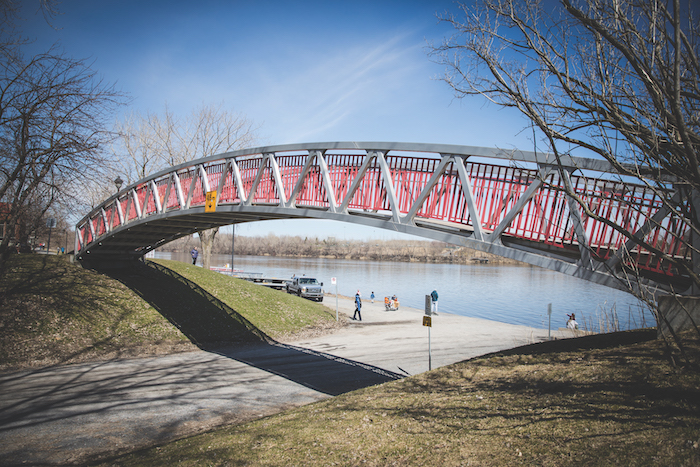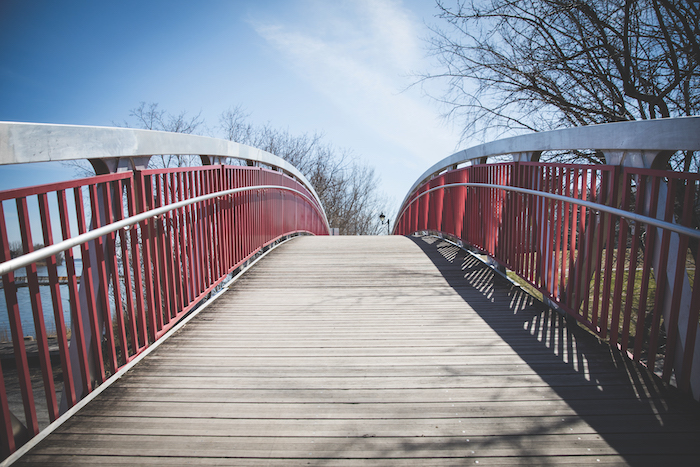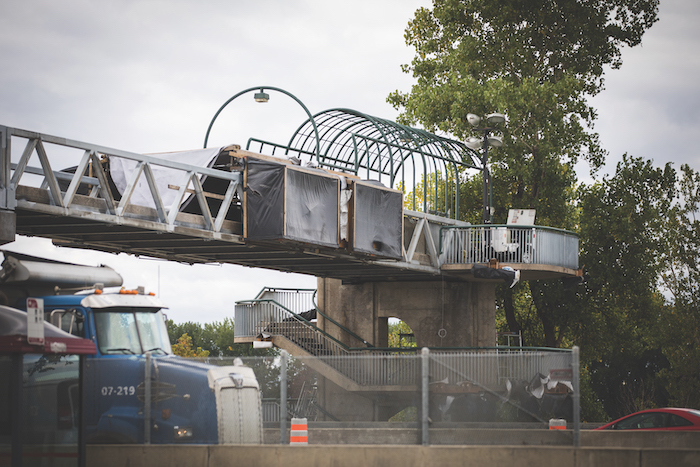
Features
Roads & Bridges
Aluminum’s advantages for bridges
A higher initial cost can yield savings in maintenance and repairs
December 29, 2020 By Alex de la Chevrotiere, P. Eng., and Martin Hartlieb
 Photos courtesy MAADI Group and Viami International.
Photos courtesy MAADI Group and Viami International. Aluminum became a common construction material choice relatively recently. Today, it is successfully used for many applications. Its low weight is an advantage for cars and planes, for example, to improve their fuel efficiency. It is the most easily and frequently recycled material and offers the highest scrap value. And it is a durable option for buildings and structures.
Steel and concrete were the dominant materials for pedestrian and vehicular bridges for decades, while aluminum was given little consideration. Today’s architects, however, have recognized the advantages of aluminum with regard to total cost of ownership (TCO); while the initial costs of construction and installation are higher, the ongoing costs of repairs and maintenance are lower.
That said, early attempts to use aluminum in bridges were not always successful, as engineers did not yet fully understand the material and how to work with it. Only now is that changing.
Attractive characteristics
Aluminum has many characteristics that make it attractive for a variety of applications, including pedestrian and vehicular bridges.
The first, as mentioned earlier, is its high strength-to-weight ratio, which improves efficiency for its transportation, assembly and installation. Further, by reducing the dead load of a bridge deck, the live load can be increased.
Aluminum is highly resilient. It can flex under loads and spring back from the shock of an impact. It is also great for cold weather. Unlike most other materials, it does not lose its ductility when the temperature drops. Instead, aluminum actually becomes stronger at lower temperatures.
For outdoor structures, durability is its most crucial advantage. Aluminum generates an invisible protective oxide coating, providing high resistance to atmospheric corrosion.
Thanks to its high malleability, aluminum can be transformed for many applications. It offers high rigidity and energy absorption. Through extrusion, aluminum profiles can assume complex shapes, maximizing geometric properties or incorporating grooves, hollow areas or other linear features for a specific purpose.
Aluminum can be easily assembled with other materials and today’s engineers can avoid common problems, like galvanic corrosion, seen in the past.
Unlike steel, aluminum does not require paint or other protective finishing, except to enhance its appearance. Indeed, aluminum structures do not need to be painted for their entire lifetime, up to 100 years. Also unlike steel, they can be sanded or pressure-washed to remove graffiti without damaging their finish.
As mentioned, aluminum is easily recycled. Claims that steel has a smaller carbon footprint are true only for primary aluminum, which is produced from raw bauxite/alumina, but the majority of aluminum used in North America—including extrusions for bridges—contain recycled aluminum, representing a much smaller carbon footprint than steel. Aluminum has a much lower melting point and basically does not lose any of its inherent properties or quality during recycling.
Additionally, the cost of recycled aluminum is lower than that of primary aluminum.
“Early attempts to use aluminum in bridges were not always successful.”
Improved alloys
The first aluminum bridge structures built from the 1930s and ’60s were made of Al-Cu alloys, which were strong but difficult to extrude into complex shapes. They were also subject to significant corrosion problems, leading to early failures.
The introduction of Al-Si-Mg alloys, which depend on Mg2Si precipitation hardening, greatly facilitated the extrusion of beams with complex hollow cross-sections that were more resistant to corrosion. Newer bridges around the world have been made with these alloys—and, in most cases, with a high amount of recycled content or certified sustainable low-carbon primary aluminum.
Design choices are often limited by stiffness and fatigue. Most bridges today use standard Al-Si-Mg alloys with T6 temper because they offer the same modulus of elasticity and fatigue strength as special high-strength versions.
In one commercially available bridge design, weld-free aluminum decking enables a maximum allowed vehicle weight of 15 tons for pedestrian, movable, temporary and military bridges, maritime structures and construction platforms.
“The material becomes stronger at lower temperatures.”
Real-world performance
To illustrate the differences between steel and aluminum, consider two pedestrian bridges along the St. Lawrence River. The first, located in Verdun on the island of Montreal, is an aluminum bridge built 18 years ago. The second is a steel and concrete bridge installed in 1988 in Longueuil, on the south shore. A few kilometres apart, they face the same climate and were designed for the same live load.
Verdun marina mill-finish aluminum bridge
The Verdun marina bridge is a 25-m long and 3-m wide arched pony truss bridge constructed in 2002 with Cumaru wood decking by Technomarine in accordance to CAN/CSA-S6-00, the Canadian Highway Bridge Design Code. It was designed for a live load of 4.8 kPa.
Only the vertical pickets have a powdercoated finish. The rest is natural mill finish aluminum.
According to the Borough of Verdun, the bridge has never required any repairs or maintenance in its 18 years. Indeed, it should not require any maintenance or major repairs over the next few decades.

Built 18 years ago, the Verdun marina bridge, made with mill-finish aluminum, has never required repairs or maintenance.
Marigot hot-dip galvanized steel footbridge
The Marigot pedestrian bridge on Marie-Victorin Boulevard in Longueuil is a galvanized steel structure with a reinforced concrete deck, 127 m long and 3.86 m wide, featuring several simple spans with steel pony trusses. It was built in 1988.
Reinforced concrete slabs comprise the deck, which rests on steel girders arranged in three simple spans. It is longer than the aluminum bridge, but similar in width, design, use and live load.
The Marigot bridge has required repairs and regular preventive maintenance. In 2014, by way of example, the cost of prepping and metal spraying the steel surfaces and taking environmental protection measures was $302,000. Similar maintenance was needed again in 2019, by which point it cost more than $322,000—and that same year, the bearings, deck support and guardrails were replaced at a cost of $190,000.
So, the bridge needed $814,000 in repairs and maintenance over a five-year period. Additionally, several hundred thousand dollars were incurred for organization, administration and traffic management on the site.
Comparing TCO
Comparative analysis of maintenance costs confirms the TCO of hot-dip galvanized steel in an urban setting exceeds that of aluminum after 33 years. And as mentioned, a well-designed and -constructed aluminum bridge has a lifespan of 100 years. The lowest initial cost, therefore, is not necessarily the best option.
Alex de la Chevrotiere, P. Eng., is president of MAADI Group, based in Boucherville, Que. Martin Hartlieb is president of Viami International, based in Beaconsfield, Que.
Print this page
